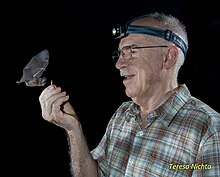Merlin Devere Tuttle | |
|---|---|
 Merlin feeding a mealworm to a little big-eared bat (Micronycteris megalotis) in Trinidad, 2016 | |
| Born | August 26, 1941 |
| Known for | Bat ecology and photography, conservationism |
| Title | Founder & Executive Director, Merlin Tuttle's Bat Conservation; Founder & Former Director, Bat Conservation International; Advisory Board Member, Disney's Animal Kingdom; Former Curator of Mammals, Milwaukee Public Museum; Research Fellow, Department of Integrative Biology, The University of Texas at Austin; Co-Director, Smithsonian Venezuelan Project |
| Awards |
|
| Academic background | |
| Alma mater | Andrews University (BA) University of Kansas (MA, Ph.D.) |
| Academic work | |
| Institutions | Merlin Tuttle's Bat Conservation; Bat Conservation International; University of Texas |
Merlin Devere Tuttle (born August 26, 1941) is an American ecologist, conservationist, writer and wildlife photographer who has specialized in bat ecology, behavior, and conservation. He is credited with protecting the Austin Congress Avenue Bridge bat colony from extermination.[1][2][3][4] Tuttle is currently active as founder and executive director of Merlin Tuttle's Bat Conservation (MTBC) in Austin, Texas.
He also founded the conservation organizations Bat Conservation International, from which he retired in 2009, and helped establish the National Park of American Samoa.[5][6] Tuttle has also published research on gray bat population ecology migration,[7][8] and the frog-eating bats Trachops cirrhosus.[9]
Tuttle's photography of bats has been featured in numerous National Geographic Society publications, including 100 Best Pictures and 100 Years of Adventure and Discovery.[10][11][12][13] In 2002, the United States Postal Service released a commemorative stamp series featuring Tuttle's photographs.[14][15] In 2019, Tuttle served as science editor and photographer for the Smithsonian Books publication BATS: an illustrated guide to all species. He has received accolades for his research and conservation work, including the Gerritt S. Miller Jr. Award, and has been honored by the Texas State House of Representatives.[16]
In 2015, Tuttle published his memoir, The Secret Lives of Bats: My Adventures With the World's Most Misunderstood Mammals.[17][18][19]
- ^ "Merlin's History in Bat Conservation - Merlin Tuttle's Bat Conservation". www.merlintuttle.org.
- ^ "The Year Austin Wanted to Exterminate the Bats". September 24, 2019.
- ^ "History of Austin's famous Congress Avenue bats flies from hysteria to city treasure". CultureMap Austin. 4 May 2018.
- ^ "Archived copy" (PDF). Archived from the original (PDF) on 2015-02-13. Retrieved 2020-07-18.
{{cite web}}: CS1 maint: archived copy as title (link) - ^ "BATS Magazine Article: BCI Helps Samoans Gain National Park". www.batcon.org.
- ^ NPS 1988
- ^ Tuttle, M.D. 1975
- ^ Tuttle, M.D. 1976.
- ^ E.g., Barclay, Fenton, Tuttle, & Ryan 1981; Ryan, Tuttle, & Barclay 1983; Tuttle, Ryan, & Belwood 1985.
- ^ Allen, W.L. 2001.
- ^ Digital Photographer 2007.
- ^ Cite error: The named reference
cvlinkwas invoked but never defined (see the help page). - ^ Bryan, C.D.B. 1994
- ^ "BATS Magazine Article: Bats Go Postal". www.batcon.org.
- ^ "Night Friends - American Bats On-line Activity Guide" (PDF). www.csu.edu.
- ^ "House Resolution 1008" (PDF). lrl.texas.gov.
- ^ Tuttle, M.D. 2015
- ^ "'The Secret Lives of Bats': story of a misunderstood mammal". The Seattle Times. December 20, 2015.
- ^ Pain, Stephanie. "The Secret Lives of Bats: The adventures of the real batman". New Scientist.